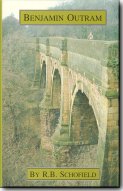Review of ‘Benjamin Outram’, by R.B. SchofieldThis review is by Julie Bunting, and was published originally in The Peak Advertiser, the Peak District's local free newspaper, on 5th March 2001, and is reproduced with Julie's kind permission.
Outram had the advantage of being a natural negotiator and was not above appealing to a man's patriotism in haggling over a price for work 'of national importance'. Unfortunately at the start of his career he fell foul of Richard Arkwright who exacted some small revenge against the brilliant younger man and who, incidentally, does not come out of the whole story at all well. Outram's work on early railways is recognised as a milestone in transport technology. Railways built to his own 'improved plan' included the 1.5-mile Crich railway, linking limestone quarries with Cromford Canal, and the 6-mile Peak Forest railway. Rails supplied by his Butterley works were laid from Bugsworth to Dove Hole quarries - a world away from London Docks, where Outram's company won an unusual railway contract. He also held far-reaching ideas for regional railway networks to provide long-distance transport, looking beyond the current use of horse-drawn railways for on-site transport for such as coal and quarry products. In 1799 he wrote: '... it is exceedingly probable that railways will soon become general for the transport of merchandise throughout the commercial parts of the Kingdom ...' Professor Outram observes that in the promotion of his ideas to the unduly cautious, Benjamin Outram was too far ahead of his time. At his death Outram lived at Butterley Hall with wife Margaret and five children, one born each year following his marriage in 1800. Prospects looked rosy but Margaret's faith that 'fortune would place us on the highest pinnacle' were to be sadly dashed when Benjamin's financial interests were revealed following his death in 1805. His personal debts were entangled with the finances of his company, from which he had made excessive borrowings against potential future prosperity. Such misjudgments are, however, placed in their true perspective in this professional appraisal of one of the outstanding civil engineers of his generation. Review by Julie Bunting |
|||
